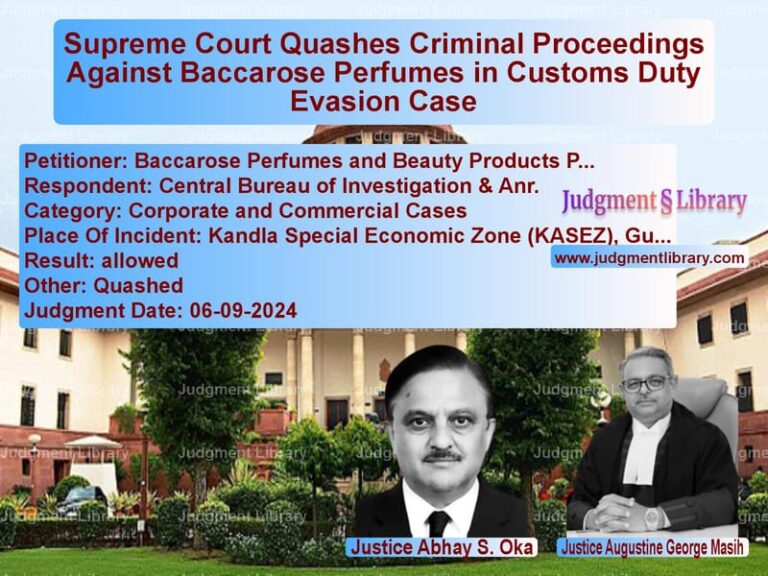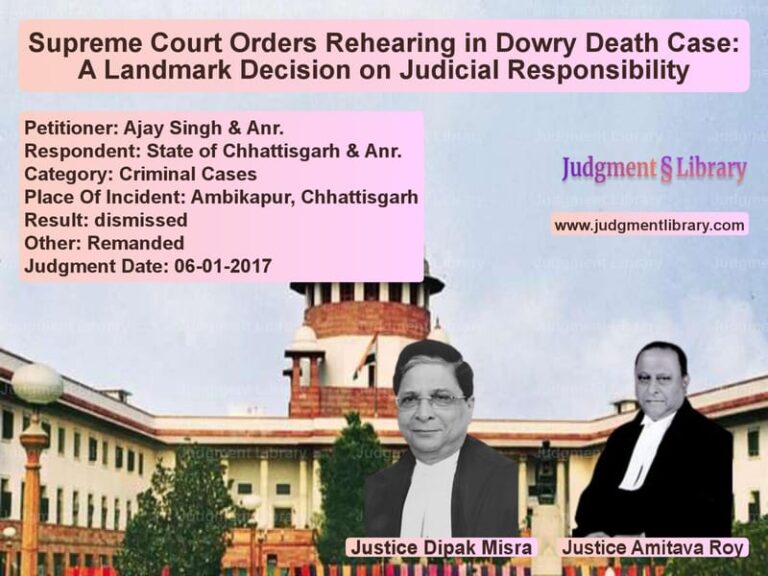Supreme Court Ruling on Unauthorized Construction in CRZ-III Area: Key Directions and Legal Precedents
The Supreme Court of India, in the case of Anil Hoble v. Kashinath Jairam Shetye and Others, delivered a crucial judgment on October 7, 2016, addressing unauthorized construction in the Coastal Regulation Zone (CRZ-III) area in Goa. The appellant, Anil Hoble, had been directed by the National Green Tribunal (NGT) to demolish a restaurant and bar built on land within 100 meters of the High Tide Line, a No Development Zone (NDZ), in violation of the CRZ Notification, 1991.
The appellant had challenged the directions of the NGT, arguing that the structure was built prior to 1991 and that the change of user from a garage to a restaurant and bar was authorized. However, the Court upheld the Tribunal’s order, affirming the legal position on construction in CRZ areas and emphasizing the strict enforcement of the CRZ regulations.
Background of the Case
The case began when the respondents filed an application before the NGT, alleging that the appellant had constructed a commercial building on a plot of land within the CRZ-III area, which is considered a No Development Zone (NDZ) under the Coastal Regulation Zone (CRZ) Policy. The respondents argued that the construction of the restaurant and bar violated the CRZ Notification, which prohibits any construction within 200 meters of the High Tide Line, except for repairs of existing authorized structures.
The appellant, on the other hand, contended that the structure existed before the implementation of the CRZ Notification in 1991 and was originally used as a garage. The appellant further argued that the change of user from a garage to a restaurant and bar was permissible, as they had received permission from the relevant authorities.
The NGT, after considering the documentary evidence, dismissed the appellant’s claims, ruling that the structure was unauthorized and had been built after the CRZ Notification came into force. The Tribunal ordered the demolition of the structure and imposed a fine on the appellant for environmental degradation and violation of the CRZ rules.
Key Issues in the Case
- Whether the appellant’s structure, originally used as a garage, could be converted into a restaurant and bar in violation of CRZ regulations.
- Whether the structure was built before 1991, and if so, whether it could be allowed for use after the change of user.
- Whether the NGT’s direction to demolish the structure and impose a fine was justified under the CRZ Notification, 1991.
Arguments Presented
Petitioners’ (Appellant’s) Arguments
- The appellant argued that the structure was in existence prior to 1991 and was used as a garage. The structure was later renovated and used as a restaurant and bar after obtaining the necessary permissions from the concerned authorities.
- The appellant further contended that the structure was not a new construction but a modification of an existing building, and therefore, the CRZ Policy did not apply to the renovations made.
- They asserted that the permission granted by the Goa Coastal Zone Management Authority (GCZMA) for re-roofing and re-flooring the structure was sufficient for the change of user.
Respondents’ (State Authorities and NGT) Arguments
- The respondents argued that the structure violated the CRZ Notification as it was constructed after 1991, within 100 meters of the High Tide Line, and therefore fell under the NDZ where no construction is allowed except for repairs of existing authorized structures.
- The respondents further emphasized that the structure had been used for commercial purposes, which was prohibited in the CRZ-III area, and that the appellant’s claim of political influence in facilitating the construction was a serious concern.
- The NGT also argued that the appellant had failed to comply with the procedures under the CRZ Notification, as the permissions granted for the structure were contrary to the law.
Supreme Court’s Judgment
The Supreme Court dismissed the appeal and upheld the NGT’s order for the demolition of the structure. The key observations of the Court included:
- On CRZ Regulations: The Court reiterated that the CRZ Notification, 1991, imposes strict restrictions on construction within 200 meters of the High Tide Line in CRZ-III areas. It emphasized that only repairs and renovation of existing authorized structures were permissible, and any new construction was prohibited.
- On Change of User: The Court found that the appellant’s structure, initially a garage, had been substantially altered and converted into a commercial restaurant and bar, which was in violation of the CRZ Policy. The Court held that such a change of user was not permissible under the CRZ regulations.
- On the Appellant’s Claim: The Court rejected the appellant’s argument that the structure was built before 1991, stating that the structure was different in shape, size, and location from the original structure and could not be considered as a pre-existing building for the purposes of the CRZ Policy.
- On Environmental Degradation: The Court agreed with the NGT’s finding that the construction of the restaurant and bar in the CRZ-III area led to environmental degradation and violated the Coastal Regulation Zone rules. The appellant was directed to pay a fine of Rs. 20 lakh for the environmental damage caused.
The Court stated: ‘The CRZ Notification prohibits any new construction within 200 meters of the High Tide Line in the No Development Zone. The appellant’s structure is unauthorized, and it must be demolished in accordance with the law.’
Key Legal Precedents Cited
- Goa Foundation v. Panchayat of Calangut and Others (2013): The Bombay High Court’s decision that unauthorized structures in CRZ-III areas must be demolished and that permissions for such constructions are invalid unless they comply with the CRZ regulations.
- State of Goa v. Union of India (2003): Held that construction in CRZ areas, especially after 1991, is strictly regulated to protect the coastal and river ecosystems.
- Friends of Goa v. State of Goa (2011): Addressed the issues related to unauthorized construction in CRZ zones and emphasized the need for compliance with the CRZ Notification for protecting the environment.
Impact of the Judgment
The Supreme Court’s ruling has several significant implications:
- Reinforcement of Environmental Protection: The Court’s decision reinforces the importance of adhering to the CRZ regulations for the protection of coastal ecosystems. Unauthorized construction in CRZ-III areas can lead to environmental degradation, which the Court aimed to prevent.
- Clarification on the Change of User: The ruling clarified that a change of user from residential to commercial or any substantial modification of structures in CRZ areas is not permissible under the CRZ Notification.
- Authority of NGT and State Authorities: The decision strengthens the role of the NGT and the Goa Coastal Zone Management Authority (GCZMA) in enforcing environmental regulations and taking action against violations in CRZ areas.
Conclusion
The Supreme Court’s judgment in Anil Hoble v. Kashinath Jairam Shetye and Others serves as a significant precedent in the enforcement of the CRZ Notification, ensuring that the construction and renovation activities in coastal areas comply with environmental regulations. By upholding the demolition of unauthorized structures and the imposition of fines for environmental violations, the Court emphasized the need to protect the coastal ecosystems and uphold the rule of law in regulating land use in sensitive environmental zones.
Don’t miss out on the full details! Download the complete judgment in PDF format below and gain valuable insights instantly!
Download Judgment: Anil Hoble vs Kashinath Jairam She Supreme Court of India Judgment Dated 07-10-2016.pdf
Direct Downlaod Judgment: Direct downlaod this Judgment
See all petitions in Environmental Cases
See all petitions in Contract Disputes
See all petitions in Property Disputes
See all petitions in Judgment by T.S. Thakur
See all petitions in Judgment by A M Khanwilkar
See all petitions in Judgment by Dhananjaya Y Chandrachud
See all petitions in dismissed
See all petitions in supreme court of India judgments October 2016
See all petitions in 2016 judgments
See all posts in Environmental Cases Category
See all allowed petitions in Environmental Cases Category
See all Dismissed petitions in Environmental Cases Category
See all partially allowed petitions in Environmental Cases Category







